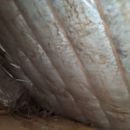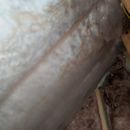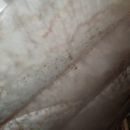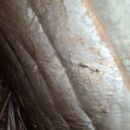Condensation issue with blown-in insulated rafters
I just looked at an attic space that is next to a finished room. The rafters are insulated with blown-in insulation of some kind, held up with netting, and then the face of the rafters is covered with stapled-up plastic (polyethylene?). The netting and the plastic have brown streaks from water dripping, very consistently in every bay. There is no damage to drywall in the finished rooms, nor evidence of water problems on the roof sheathing in attic space above the finished rooms (where the ceiling is insulated instead of the rafters), so i know this is not a bulk water problem. That leaves condensation, right? There is enough water evidence that I think this is a problem that needs addressing. The house is not too old, I think he said under 20 years. The materials and construction techniques I saw seem modern.
What would cause this kind of condensation in rafters?
I know you’re going to ask about rafter depth, deck venting. I didn’t tear into the plastic, netting, and insulation to find out. I probably should have, and I’m guessing the next step is to go back and find out.
GBA Detail Library
A collection of one thousand construction details organized by climate and house part













Replies
This looks to me like an example of a hot roof (unvented roof) done wrong. Moisture is probably getting in as it always does, condensing on the underside of the roof sheathing, then dripping down through the blown insulation and running down the poly where it’s trapped. There is probably rot and mold in there too.
I expect you’ll need to remove this and redo it properly, and there’s a good chance you’ll have to replace some of the roof sheathing too. Personally, I’d either replace it with a vent channel and mineral wool, or closed cell spray foam depending on what you need to achieve.
Bill
Thanks. Hoping we found it before rot! There was rot in the attic space above the finished rooms, where the blown-in is in the ceiling rather than the rafters. It was blamed on a faulty shower vent, which was addressed, but now I'm wondering if there was more going on and if it's in the rafters below as well...
Bathroom vents blowing into the attic will certainly contribute to moisture problems, but so will any air leaks from the interior and there are always air leaks.
A cheap borescope might save you a lot of work here looking for hidden problems. There are some available on amazon for around $30-50 or so. They’re not the same quality as the $500+ pro stuff, but they get the job done.
Bill
Hi Aaron.
Bill's likely right about what is going on here. However, you didn't say where this house is located. Are you in a heating climate?
Once you tear all this out, you'll have to determine how to redo it right. I suggest you read this: How to Build an Insulated Cathedral Ceiling.
Sorry, yes I'm in Climate Zone 6, central New Hampshire. It tends to be very dry in the winter. Thanks for the link.